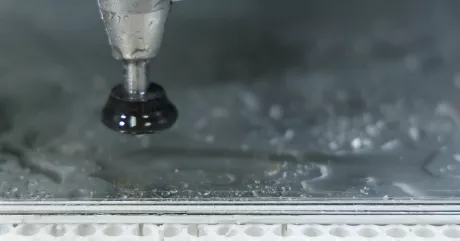Tips & Tricks
Cutting Stacked Material
When cutting a lot of very thin parts, stacking the material may be beneficial, especially if there is a lot of rapid traversing or workpieces that require time-consuming fixturing. Some of the benefits of stacking are that it cuts down on setup time for very thin materials and can reduce the amount of rapid traversing per part. Stacking may also reduce taper and the amount of burr remaining on the workpiece’s bottom edge.
Stack Height Calculator

OMAX has built a Stack Height Calculator into MAKE. The Stack Height Calculator determines what the optimal number of pieces of material is for the current part and material. The optimal number is what will provide the most parts in the least time. This tool helps you determine whether or not stacking is worth the effort and approximately how high of a stack should be used.
To find the Stack Height Calculator, go to the Change Path Setup screen in MAKE. Between the dialogue box for “Thickness” and the word “Inches” (or “Millimeters” if you are using metric), there will be a button, which will open the Stack Height Calculator.
In the calculator, you simply need to add in the thickness of the material and how many layers you plan to stack. You can also input additional layers to compare machining times; by adding in more layers, you may find that 12 layers cuts at the same rate as 10.
Always test the results by making a single part with the recommended number of sheets. The material may turn out to be difficult to fixture, or may move during machining.
The optimal stack size for a given material, thickness and pump setup depends on a number of factors. If a path has a lot of corners, for example, then the cutting speed constraints as the waterjet head moves around corners results in increased slowness as a function of thickness. For a part with few corners, a thicker stack may be more reasonable. For this reason, the Stack Height Calculator calculates using the actual tool path itself.
The Stack Height Calculator does not consider corner passing, lead optimizations or A-Jet Taper Removal in its calculations. Because of this, the actual optimal stack height may differ from the estimate calculated in MAKE. When in doubt, enter the thickness of the stack into the material thickness dialog and allow MAKE to do a full calculation. For A-Jet-equipped machines, taper removal is not considered at all in the calculation, which may result in a significant reduction in the Stack Height Calculator’s ability to give a precise estimated stack size.




